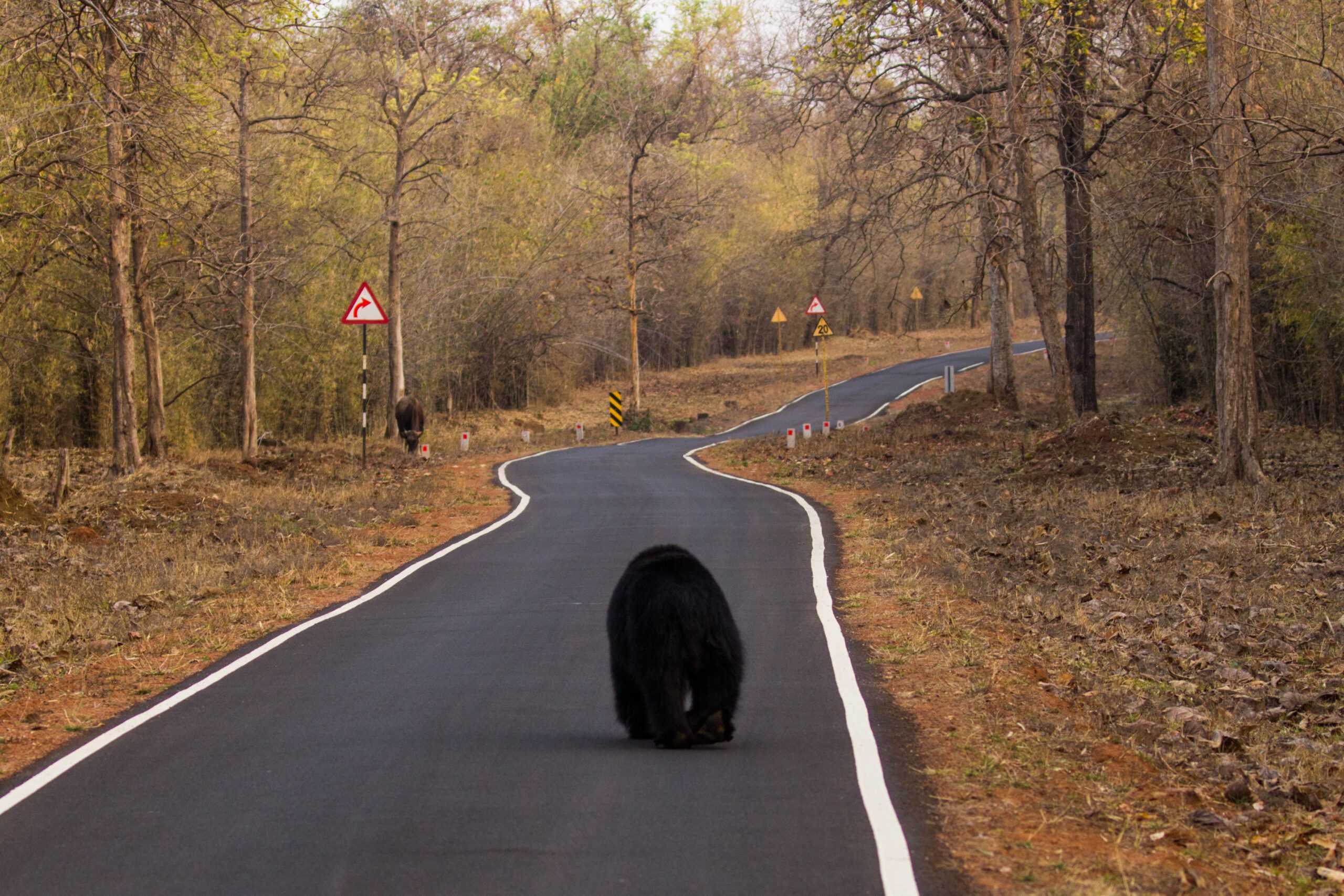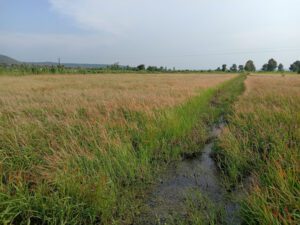Tadoba in Maharasthra’s Chandarpur district is a rich amalgamation of culture, mythology and nature coming together in a perfect communion. The rich biodiversity of Tadoba and the historical landmarks in the forest landscape, are a true testament of an ancient, flourishing dynasty, dating back to as far as 184 B.C.
The fascinating history of Tadoba is one of gallant kingdoms, a revered tribal chieftain, and inscribed rock shelters and more. Let’s take you down a little journey, into the annals of history, to the Land of Gonds and beyond. A terrain where culture and nature are inevitably entwined.
According to many a historians the biodiverse forests of this region gave Maharashtra its name – from the term “maha kantara” or the great forests.
Archaeological Wonders
Rock Shelters in Chandrapur: There are eight painted rock shelters in Chimur. These reveal the fauna of Tadoba like bears, tigers, wild pigs, barasingha deer and humped cattle. If you are on a tiger safari in India these are animals which you may see. What’s unique is that hunting scenes common in Neolithic painting are absent. The paintings date back to the Mesolithic era (7000 B.C. – 500 B.C.) and Iron age (1000 B.C. – 500 A.D.) to the historical period. At the Waghai hills two different clusters of rock shelters exist, named Nagargota and Pandubara. They are from two different time periods.
Tombs and Excavated sites: The distinct burial sites from the Iron age (Megalith era) have use large stones. Vidarbha has several burial sites that use dolmens (usually a single chamber megalith tomb), stone circles, cairns (mound of stones used as a memorial), menhirs (tall upright stone), capstone cists (box grave built of stone slabs).
Recently between 2010-2013, a double chambered dolmen was found in Hirapur, in the Tadoba forest zone. The local tribals till date continue to worship it as “Mandavgota” but to cremate and not bury. Glass bangles, Iron equipment and cooper coins were also excavated from this site.
Gond Pillars: A blend of living and non-living heritage is offered when one enters the Mohrali range leading to the Tadoba lake. The Gond Pillars are a reminder of the bygone era. These pillars are believed to be the oldest organised long-distance communication system in India. Almost 9 feet tall, with tapering tops, these pillars were used to communicate to the two temples within the reserve, the arrival of his royal highness. The were erected all the way to the King’s capital. The top of the pillars had a ring fitted, through which passed a rope that linked to the temple bell.
If you chance upon these pillars on your wild life safari, take a moment to revel in the silence of the forests, and go back into the 16th century of the Gond rule. Who knows, you might hear the bells ringing, and probably have one of the descendants of the tigers from the yeter years make a grand appearance.
Religious Relics
Ramdegi: This is one of the sites that Lord Ram spent time in during his 14 year exile.
Ramdegi is a rural hamlet in Chimur. A Shiva temple stands here. Not just a popular site with pilgrims, but tigers walk here boldly under the cover of the dark night. It is also a great habitat for sloth bears. The waterfall and the lush habitat of Ramdegi make it a preferred site for most visitors.
Buddha Vihar in Ramdegi has Buddha idols around an old banyan tree, and is a highly revered spot.
The Gond Dynasty
The rich biodiversity of Tadoba is a witness to the valiant Gond King’s who ruled for centuries. The forests were home to three tribes in the 7th century – the Gowaree, Gond and Manna. The Gond’s overpowered these tribes between 1318 and 1323. Eventually their kingdom was conquered by the Marathas in 1751 A.D.
The ancient Gond dynasty unravels the story of the village chieftain, Taru after whom the forests were named Tadoba. Legend goes that Taru encountered a massive tiger near the Tadoba lake. What ensued was a valiant battle and the tiger was killed. One such legend also claims that it was Taru who was killed by the tiger.
Taru is revered as a deity by the locals who believe they are his deity and descendants. The reserve has several shrines dedicated to King Taru. The local tribes still continue to gather every Pausha (December/January) to appease their deity.
Mythology of Sage Agastya: It is believed the Vindhya mountain range here traditionally considered the boundary between North and South India was lowered by sage Agastya. Agastya asked the mighty Vindhyas to lower itself to allow his passage to South. The mountain thereafter kept its promise not to grow until Agastya returned which he never did. He settled in the south and the Vindhyas never grew.
Big 5 of Tadoba
Tadoba overflows with a rich biodiversity of flora and fauna and is home to an array of species of various shapes, sizes and colours. Its verdant forests are a visual treat and offer extraordinary encounters.
The vast stretches of bamboo and numerous natural; and man-made perennial water bodies offer an ideal habitat to the teaming wildlife of this land of Taru.
It is not uncommon to see tigers like Sonam or one of the strongholds of Tadoba sauntering casually on the tar roads that run through Tadoba.

The Big 5 of Tadoba include: Leopards including a black panther named Blacky, Sloth Bears, Wild Dogs, Guar, the regal king of the forests, Tigers who have been allotted the pride of the place. Having said that we can’t miss the Marsh Crocodiles in the Telia and Tadoba lakes, at number 6!
The tigers of Tadoba are given exquisite, celebrity names such as: Maya, Tara, Matkasur, Chota Matka, Geeta, Lara, Gabbar, Mona, Madhuri, Amitabh, Mallika etc.

The best tiger habiatas also double up as ideal habitats for Leopards and Dholes (Wild Dogs). Interactions with these carnivores along with tigers is not uncommon, in this fascinating forest. Recently a black leopard or a melanistic leopard was also sighted here.
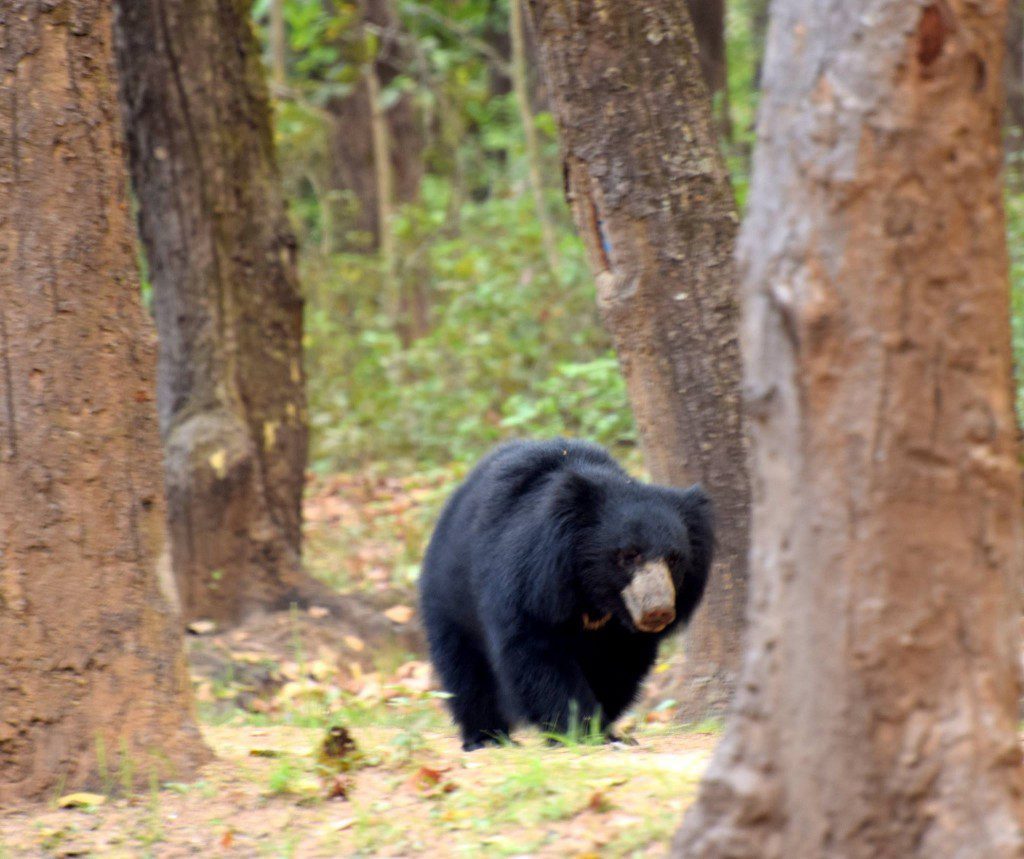
Tadoba is also a paradise for Sloth Bears that can be found nosing around for termites, fruits and larvae. And on many occasions piggy backing their young ones, or doing a ramp walk on the tar road.

The Indian Bison or Gaur is the shy, iconic denizen of Tadoba that towers over the landscape with its hugely noticeable persona. Males weigh close to a tonne. Their conspicuous white stockings and brown coat, make them a every nature photographers fascinating subject.
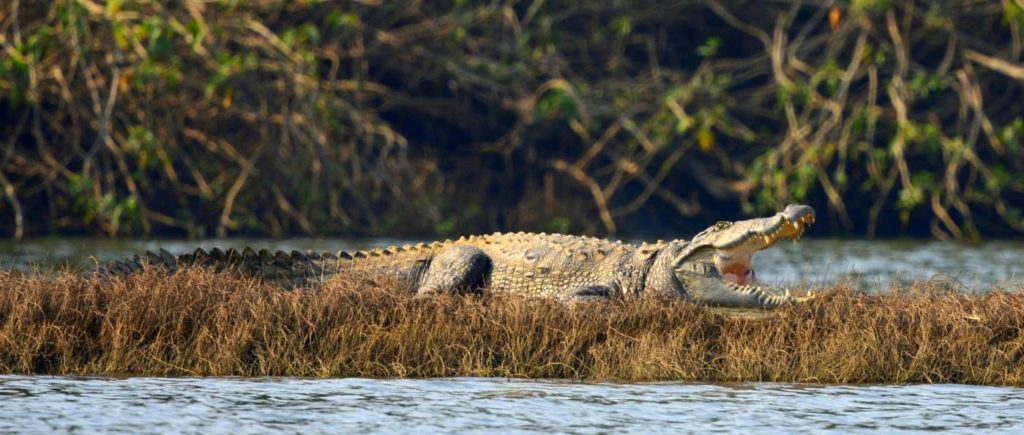
Marsh crocodiles or muggers of Tadoba are a ray of hope to the othewise dwindling numbers of this species. These fresh water reptilians and hole nesting species can be seen at the Tadoba and Telia lakes, basking in the morning sun. Or sometimes stealthily swimming in search of a prey.
Other reptiles like the stunning Indian chameleon and a variety of snake species are found in this flourishing land.
Tiger Territories in Tadoba
Tigers here are known to have territories around lakes, unlike other parks which are mostly grassland driven. For instance, Choti Tara can be seen in Jamini lake and Sonam in Telia lake. The tigers can be spotted around these lakes; especially in summers they spend a considerable time around these lakes; offering the guests great sighting opportunities.
Tigers are known to be adept swimmers. Tadoba tigers can be seen in the summers swimming and frolicking in the river bodies with their streak.
Tadoba, a Birders Paradise
Tadoba is a bird watchers paradise abounding in an explosive dance of colours where the birds wear myriad hues. Someone rightly wrote, “An ardent birder can spend days in Tadoba, lost in wonder at the range of avian denizens, without being distracted by even the thought of a tiger.”
Every perennial or man-made waterhole hosts an array of avian wonders. High value birding hot-spots include Irai lake, Ambepath, Jamun Jhora, Kala Amba, and various pools around Andhari river and Waghdoh area.
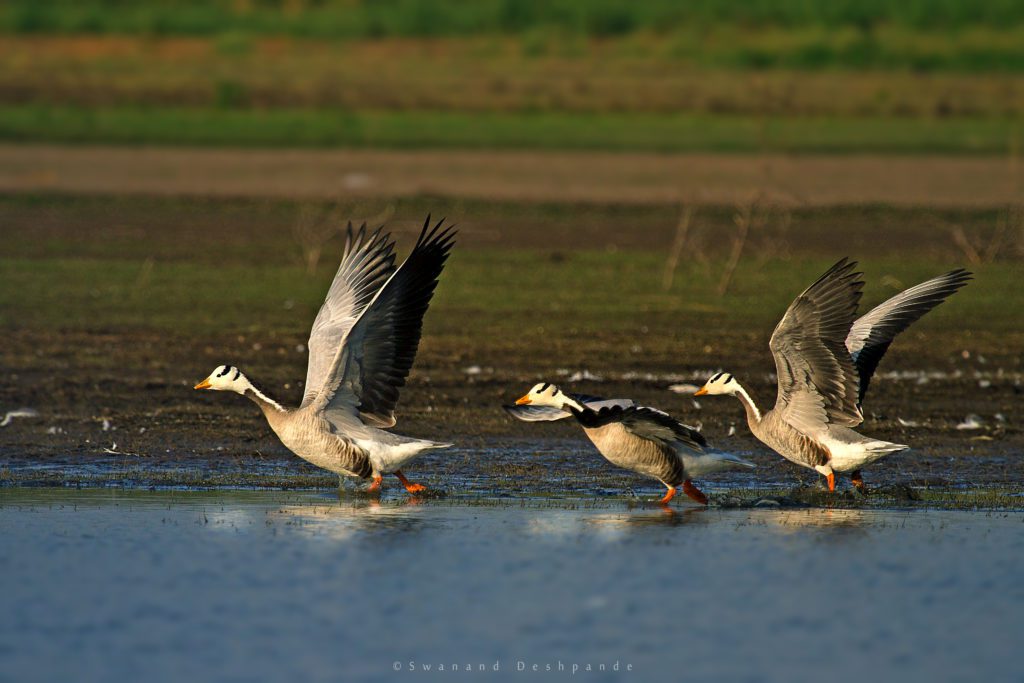
Tadoba and Irai lake host a number of migratory and native birds like bar-headed goose, lesser whistling duck and grey-headed swamp hen etc.
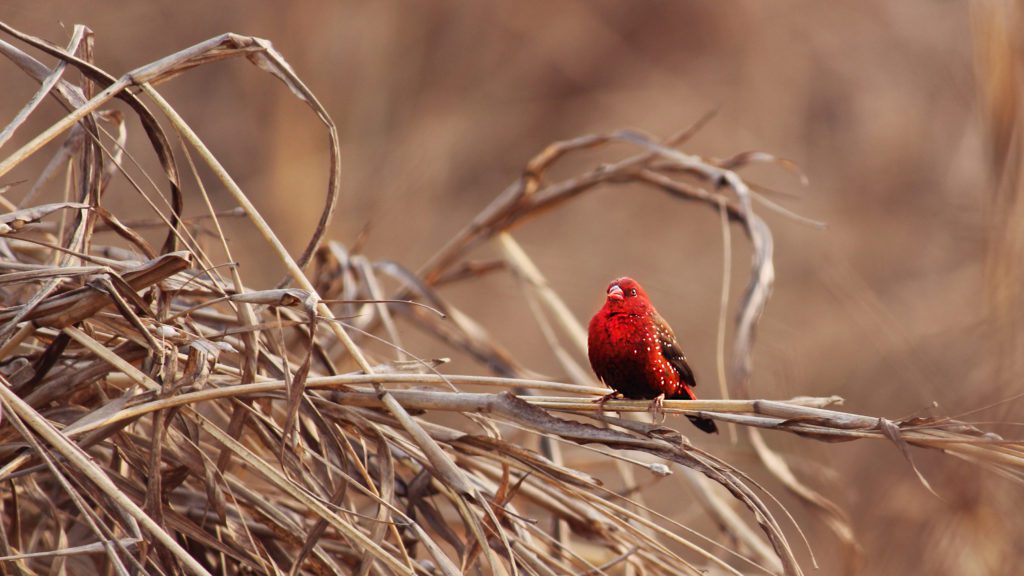
Tadoba has a variety of owls like Mottled Wood-owl, Brown Fish-owl and other passerine birds like Oriental White-eyes. The perching birds of Tadoba include Minivets, White-throated Kingfisher, Stork-Billed Kingfisher, Plum-headed Parakeets, Red Avadavat, Indian Roller, Coppersmith Barbets and plenty of others.
Tadoba Lake is a favourite haunt for raptors like White-eyed buzzards, Oriental honey buzzards and also paradise flycatchers, Indian rollers, Indian pitta etc.
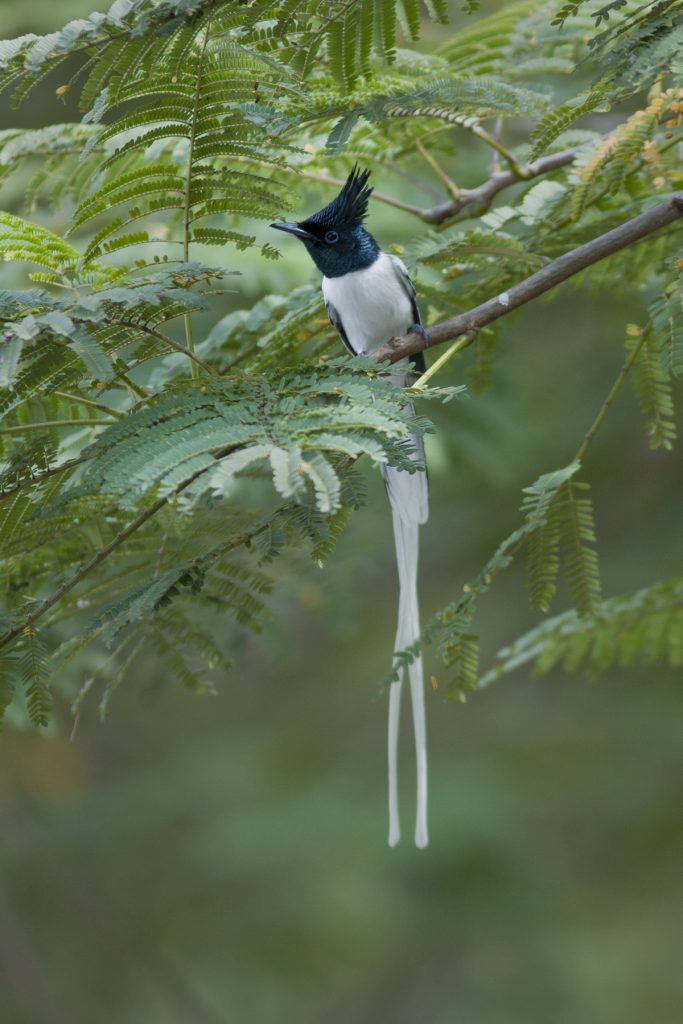
Irai lake, an exquisite water body spread across 30 sq. kms dotted with inlets, islands and bays provides stunning vistas for birds and bird watchers alike. Every canoeing trip will ensure sightings of Knob-billed Ducks, Bar-Headed Geese, Red-Crested Pochards, Small Pranticole, among others. Grey- Headed Fish-eagle and the Ospreys, which are rare to spot in other habitats are easily spotted here.

Telia lake is also good for spotting Ospreys, River Terns and Lesser Whistling Ducks. Also home to Sonam, the regal tigress.
Tadoba Lakes and Water Bodies
Though dry climatically and otherwise, and amongst the hottest in the country, Tadoba has several lakes, saucers, water holes – perennial and even man-made.
These lakes ensure the flora and fauna of Tadoba thrive like no other.
The pristine Tadoba lake can be accessed from the core gates and Irai lake from buffer zone safari.
Irai lake is an exquisite water body spread across 30 sq. kms dotted with inlets, islands and bays provides stunning vistas. Irai lake can also be reached from outside the park and one can enjoy walks. Canoeing and trekking around Irai lake can throw up some stunning surprises.
Canoe rides are offered from Moharali and Thekkady and a boat ride across the lakes leads to Pradhi Ambhora, one of the best photographic hides of Tadoba. Thus offering the best of walking trails and paddling experiences.
Telia lake also offers excellent birding opportunities and sighting of tigress Sonam, if you get lucky.
Trivia
#DidYouKnow
- The tigers here are named after a lot of Bollywood stars and have the most unique names.
- Tadoba’s history dates back to Mesolithic Era and Iron Age.
- Tadoba and Chandarpur are one of the hottest places on earth.
- Tadoba is named after the village chieftain, Taru who fought a valiant fight against a massive tiger.
- A new species of gecko was discovered in our upcoming campus a few years ago in Tadoba: Cartodactylus varadgiri (old name Geckoella collegalensis).
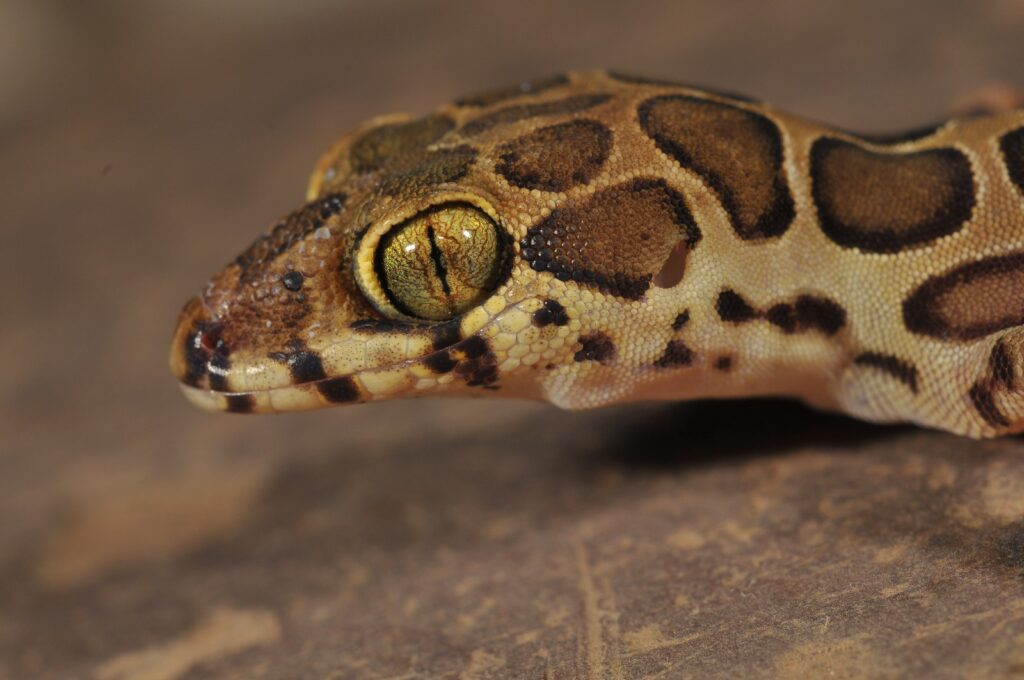
- Devdhan: The ancestor of rice, Oryza rufipogon also known as Devdhan or wild rice or red rice, grows in plenty around streams and stagnated water during monsoon. Can be found near our up coming lodge campus too.
- Horse deities: Horses are worshipped as tribal deities in Tadoba. Though it is believed tribals never used horses. Central India had a wild species of horse, Equus namadicus that became extinct about 10,000 years ago. It is possible that it survived in tribal folklore and later began to be worshipped as a deity. Alternatively this might have something to do with Mughal or British influence.
- Tiger deity: The tiger is also worshipped as a god form and many crude stone images of it can be found in and around Tadoba.
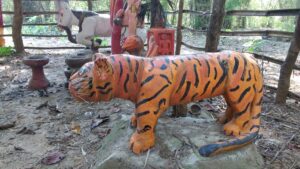
- Auspicious anti-clock: In the Gond culture anti-clockwise rotation is auspicious, whereas clockwise is evil. Their temples have anti-clock wise ‘pradakshina‘. So when these people started using wall clocks, they got anti-clocks made. Such clocks are only available during Gond festivals.
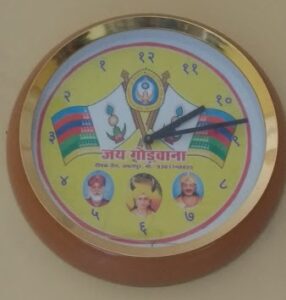
- Two famous films were made on the Tiger Sisters of Telia and also Maya.
The Waghoba Eco Lodge in Tadoba, by Pugdundee Safaris, is to open from 1st October, 2021 onwards. This sustainably constructed lodge is all geared to set new standards in eco-friendly construction. It has 14 exclusive luxury cottages, done in hand made bricks and local stone. A swimming pool, organic vegetable and herb garden, nature library and a lounge, and a man-made hide for bird watching. The lodge is about 15 minutes’ drive from Khutwanda gate of Tadoba, and about 30 minutes from Moharli gate.
As you plan a trip to this flourishing tiger country, get in touch with our trip curators at Pugdundee Safaris.
Call us at: +91-9718637711, +91-8800637711 Email: [email protected]
We promise you a wilderness holiday you are sure to treasure for times to come.
Written By: Natasha Sinha

